LA County Library Is Library of the Year 2019
Connecting directly with customers to find out what they want and need; training staff to focus on equity and to recognize and eliminate hidden biases; developing programs and services for underserved and marginalized populations; and seeking out public sector and private partners made LA County Library a model for the future of libraries and the Gale/LJ Library of the Year.
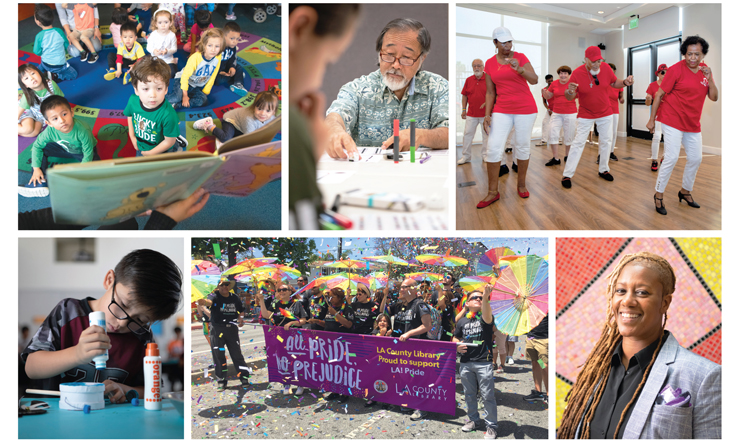
The LA County Library is the 2019 Gale/LJ Library of the Year. That accolade is story enough, but this year the news is enhanced by another breakthrough. With this win, LA County Library becomes the only library to win the Gale/LJ Library of the Year award in the same year that its director was named LJ’s Librarian of the Year—that’s Skye Patrick. And, in late 2018, LA County Library had developed such dynamic, skillful ways to tell its story that its marketing team won the LJ Marketer of the Year Award.
This impressive hat trick was set in motion in 2016 when Patrick took the helm as director, bringing a vision that has since transformed the library system. That ideal focuses every LA County library and service on equity of access and education for every person in the 3,000 square mile area served by the system, no matter their age, gender, ethnicity, origin, sexual orientation, socioeconomic or legal status, nationality, or physical ability and has spurred robust innovation, organizational change, and broad implementation of new approaches across the library system.
A PLACE FOR EVERYONE
Patrick’s work in great library systems in Queens, San Francisco, and Broward County, FL, as well as the University of Pittsburgh, gave her opportunity and “awesome” leaders, but her vision for LA County Library was more the product of her own personal experience.
“My experience as a young librarian was one of isolation. I always felt under-represented, even though I worked in huge metropolitan places. I was not seeing leadership that reflected me, [or] queer presence the way we see it now. I always felt weird and unwelcome in this profession. I never felt accepted. I never felt there was a place for me. I felt that isolation strongly enough to decide at one point to leave the profession.” Patrick says.
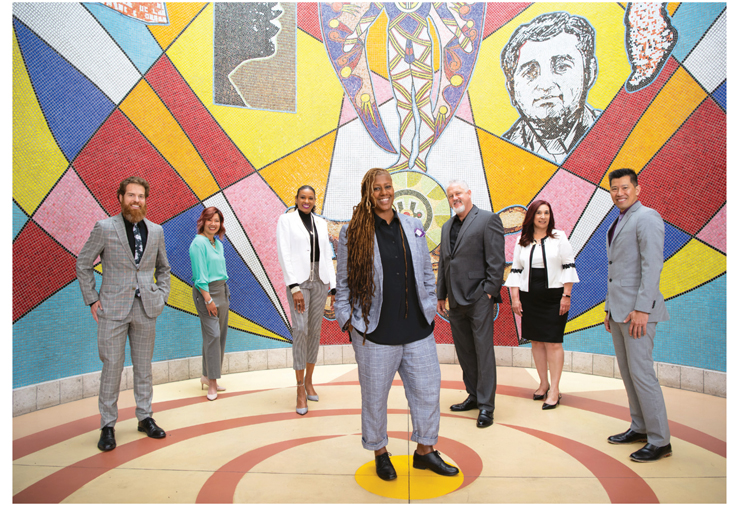 |
Director Skye Patrick (c.) and her LA County Library team (l.–r.): Jesse Walker-Lanz, Grace Reyes, Yolanda De Ramus, Pat McGee, Debbie Anderson, and Binh Le. Photo by David Zentz |
“Because of that I wanted to try to make sure that the next generation of librarians could really see themselves in a more welcoming way. That explains my desire to train people not only to fully engage with the community, [but] to engage with each other,” Patrick says, to ensure that the library she leads fights that feeling of isolation for all staff members as well as all patrons.
“It was a big change when Skye Patrick came. She brought a vision and we’ve all been working with her for three years to help implement” it, says Jesse Walker-Lanz, Assistant Director for Public Services. That full throttle effort by the entire team at every level is why LA County Library is Library of the Year.
IMPLEMENTING CHANGE
Beginning in 2017, the library launched the iCount program, holding a series of town hall style meetings to connect library leaders face-to-face with stakeholders and customers from all the varied communities the library serves.
“The iCount and equity initiatives really challenged our staff,” says Walker-Lanz. “The library chiefs had to come together and figure out which groups in their local communities they might not be fully serving. They had to formulate a plan on how they could address that inequity. We have just kicked off our third year of iCount. ICount made all of our staff much more mindful about equity. Now they really think about whether all of our decisions foster equity.” Part of what made this work, he says, is that local staff in each branch don’t just implement a global, top-down to-do list. Instead, staff at all levels sit down to use an equity lens to determine which groups “might not be fully served in their particular community.”
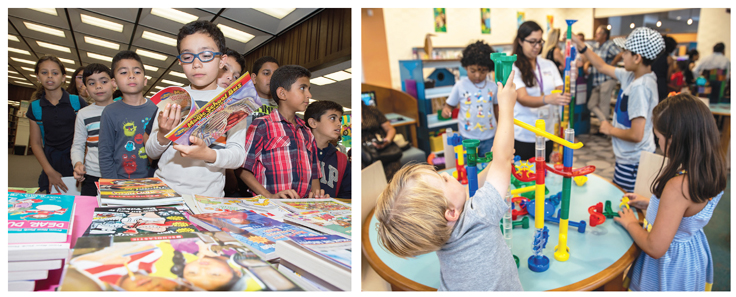 |
KIDS ALL IN Young readers pick books to take home after Family Storytime at the Clifton M. Brakensiek Library; Youth attend a STEAM program at the Willowbrook Library’s Grand Opening. Left photo courtesy of LA County Library; right photo by Monica Almeida |
“We’ve been working in the iCount Leadership Committee for three years. An amazing group, we have figured out simple ways to help staff develop programs and services that address an equity issue in the libraries in their communities. Now we see everything we do through the lens of iCount. It has changed our culture,” says Debbie Anderson, Assistant Director for Education & Engagement.
After iCount training on equity and implicit bias, each library in the system annually creates a Library Equity Action Plan. The result is staff, programs, and services focused on real needs and equity, and transformed to go far beyond the traditional scope of public libraries. It offers models of service, programs, and collections for every other library nationally and worldwide.
BY THE NUMBERS
Established in 1912, LA County Library is one of the largest public library systems in the United States, and the world, serving 3.4 million residents. The system has 87 libraries; three book kiosks at housing sites for older adults and youth between the ages of 16 and 24 who are in transition from state custody or foster care; and a fleet of 18 vehicles comprised of three bookmobiles, five Reading Machines to support early literacy programs offsite, and ten MākMō mobiles, a mobile delivery system to support makerspaces and promote Science, Technology, Engineering, Arts, and Math (STEAM) programs.
The annual budget of $208,898,000 provides per capita support of $61.93 for each county resident. Those library users borrowed 10,767,071 items from collections in fiscal 2017–18 and 10,300,859 visited a library to get those materials and many other services, among them answers to 6.7 million reference questions. LA County Library’s digital resources delivered more than 2 million e-circulations (increasing 29-33 percent a year), 4.4 million Wi-Fi sessions, and 2.2 million Internet sessions last year.
A staff of 695 full time equivalents is augmented by nearly 1,700 volunteers. Of that staff, 39 percent are professional librarians.
LA County Library’s 26,400 programs attracted more than 619,000 participants in total. An amazing 499,512 came to children’s programs, up four percent from last year. Some 86,534 attended adult programs, up a huge 24 percent over the prior year, and 32,996 attending teen programs, an increase of eight percent.
MANAGING OPERATIONS
“All of our communities are changing all the time and it is crucial that we constantly evaluate the service that we are providing and making sure that we are keeping up. We have found a way to keep looking at what we do and to insure that,” says Walker-Lanz.
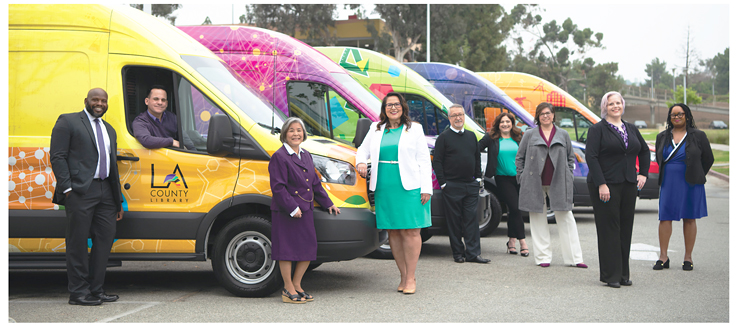 |
Regional administrators with the MākMō mobile fleet (l.–r.): Gladstone Bucknor, Donald Rowe, Carolyn Kobayashi, Patricia Rivera, Louix Escobar-Matute, Christle Chumney, Christiane Warburton, Valerie Bailey, and Ivorie Franks. Photo by David Zentz |
“A lot of credit goes to the staff that has taken the new vision and run with it. They have taken this vision and figured out how to implement it locally—a tremendous achievement. Our staff and our emphasis on making sure we understand what our communities need has been the key to success,” he adds. “I think we are really working to create a new 21st Century model of library service.”
The library’s constituents agree. “Our communities are very receptive. We get a lot of really positive customer feedback,” reports Walker-Lanz, including compliments on the team. “I think we are really known for having a friendly, helpful, supportive staff. That is one of the key reasons why communities love their community libraries.”
FROM THE GROUND UP
LA County Library’s Family Place Libraries offer over 3,400 early literacy programs attended by more than 104,000 children. Reading STARS, offered at five locations, was developed to pair adults age 50 or older with students in K-3 ages for four months of tutoring. More than 90 percent of participating students improved their reading by one level.
That said, LA County Library’s agenda to help kids and teens goes far beyond reading. The Positive Parenting Programs (Triple P) address and help prevent common behavioral and emotional problems in children and teens. While commonly used by social workers and clinicians, not library staff, LA County Library worked with Triple P to adapt its program to a library setting, and now some 40 staff members are certified Triple P providers. Nutritious lunches for kids 18 and younger are provided via the Lunch at the Library program. Personal Safety & Bullying classes teach school-age kids and their parents to recognize bullying and avoid abduction and human trafficking. In the fall, the library offers free flu shot clinics, as well as free museum passes through its Discover & Go program year round.
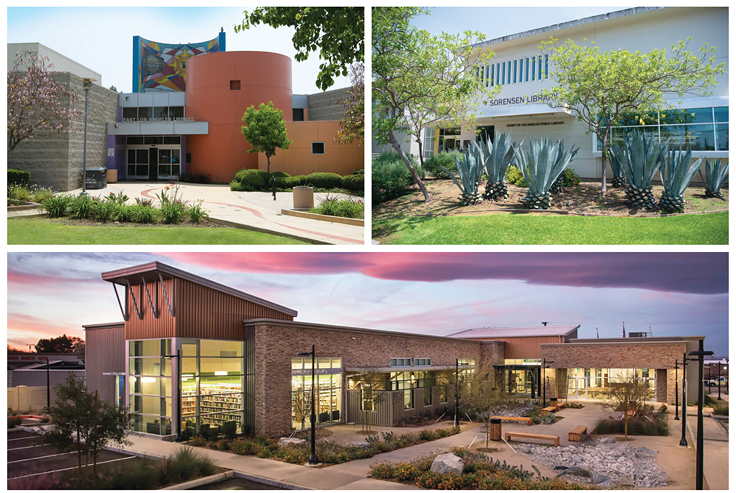 |
Branch locations: East Los Angeles Library, Sorensen Library, and Quartz Hill Library. Top row photos by David Zentz; bottom row photo courtesy of LA County Library |
The Adult 101: Life Skills Bootcamp for Teens series teaches such “soft skills” as etiquette, public speaking, and workplace know-how needed to succeed as adults. And the award-winning Turns the Tables program is a free nine week DJ course to teach technological and entrepreneurial skills. Since LA County has the highest rate of incarcerated youth in the state, the library runs two dedicated institutional libraries with guidance from specially trained librarians and curated collections.
The learning doesn’t stop at 18, either. Beyond the lifelong learning available through the collection and programs for adults, LA County Library’s participation in Career Online High School lets adults over 19 earn an accredited diploma and career certificate online. Approximately 80 students are expected to graduate in 2019.
PROACTIVE PARTNERSHIPS
On top of engaging every constituency in the county, library staff also partner with every county agency and a host of private institutions and firms to engage them in the expansion and transformation of LA County Library services to meet urgent needs. For example, LA County’s was the first public library to partner with Barbershop Books, developing training for barbers facilitated by its partner organization. To date, it has placed shelves full of reading materials in ten barbershops.
New partnerships in the last fiscal year included $25 million from the Mental Health Services Act for two years of programming targeting at-risk people using trauma-informed programs to develop protective factors to reduce the development of mental illness. Beginning in March, the LA County Department of Mental Health placed eight mental health clinicians in eight libraries. With the county Probation Department, two million dollars was used to create new programs for youth on probation. And as part of the the LA County Board of Supervisors’ new mentoring initiative, the library is hiring ten young men of color as My Brother’s Keeper Peer Advocates.
The LA County Arts Commission launched its Artist in Residency and assigned a Creative Strategist to work at libraries to develop community-specific programs and events.
To help families on the margins that cannot afford traditional daycare to prepare children for kindergarten, LA County Library redesigned story times into Smarty Pants Storytime in partnership with the County Office of Education, applying curriculum-based standards and readiness indicators in a fun, interactive setting.
 |
CREATIVE COMPANY Left: Senior residents of the Nueva Maravilla Housing Community, home to one of the library’s new book kiosks, show art they created at an on-site program; right: DJ students practice before a concert performance at South Whittier Library, part of the free Turns the Tables nine-week workshop for beginners aged 15-21. Photos by Monica Almeida |
To better serve veterans, LA County Library established four Veterans Resource Centers beginning in 2015 in partnership with the California Department of Veterans Affairs to help veterans and their loved ones find and learn about state and federal education, employment, housing, health, and disability benefits. A new pop-up veterans resource center started visiting sites throughout LA County in November 2018.
For new immigrants, the library partnered with the LA County Office of Immigrant Affairs to develop the website Path2Citizenship.lacounty.gov. It launched in early 2018, highlighting the resources for immigrants at the Office and library, which include two Citizenship Resource Centers and workshops on the naturalization process. The library’s Citizenship in a Bag kits have circulated 2,600 times since 2016 to provide settlement information for newly arrived immigrants—more than 30 percent of LA County’s population is foreign born.
LA County Library also partners with county homeless service providers at 17 high-need libraries. Many work to find permanent housing for customers. In the meantime, the library removes barriers to access to materials and services by offering patrons experiencing homelessness an address-free card.
One of the secrets to such prolific partnership is connecting to other parts of local government. Patrick “felt that other County departments didn’t know what we do, so she took me and [Walker-Lanz] around to meet with many of their leaders,” recalls Anderson. “We did a presentation on all the different things we do that are not thought of as traditional offerings of libraries. We got great response.”
They were also proactive about linking the library to other departments’ practices and priorities. “[Walker-Lanz] and I worked to align our mission and purpose with that of other departments. We did a lot of research on the strategies other departments use and we wrote our program proposals to partner with them and fit with their strategies,” Anderson says. “Once you get it going you can see how much we are allied with other people who serve the community. You find that we are all doing a lot of similar work.”
GIVING TECH A HUMAN FACE
In August 2018, the Microsoft Corporation put up $3.3 million to upgrade software on all LA County Library public computers and partner in the program called Building Digital Equity, to teach youth Microsoft programs and certify their acquisition of up-to-date digital skills and opportunities for work.
“We are doing a lot of experiments infusing AI in machine learning, but right now our customers have demonstrated more comfort and ability in a hybrid learning environment that utilizes technology along with a live person to help navigate the playing field,” says Patrick. The library learned a lot from community engagement sessions. “We discovered that we need live people in the technology learning mix,” Patrick explains. “We thought we knew what customers desire to know and we thought they could really utilize technology in a learning environment. What we learned when we asked them is that they are not there yet. To most people technology is still a sort of weird wildebeest.”
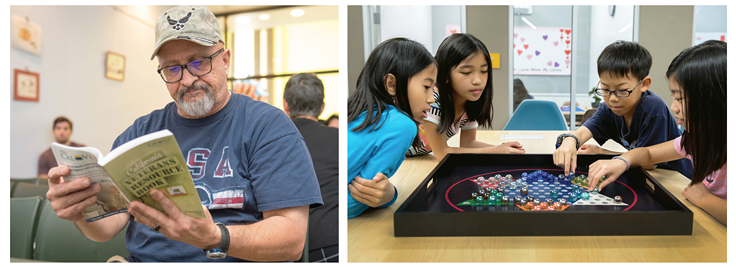 |
LIFELONG LEARNING (l.-r.): A veteran peruses the California Veterans Resource Handbook at the grand opening of one of the four new Veterans Resource Centers, this one at La Puente Library; Teens play a game of Chinese checkers during the Grand Re-Opening of Rowland Heights Library. Left photo courtesy of LA County Library; right photo by Monica Almeida |
The library applied its learning to education efforts as well. “Most still don’t feel they have a successful hand on it when they use technology in education, they told us,” says Patrick. “So informed, we developed a hybrid learning environment where real people provide real instruction with technology. In one partnership, for example, we are working with Explore.org. We live streamed one of their deep sea divers in the Indian Ocean into a story time. Then we had the ability to allow people inside the library and outside it to participate in the story in the live stream in real time and use the smart technology to draw pictures of the sea animals.” That, Patrick notes, is a test case, and the LA County Library team looks forward to expanding the model to seniors as well.
Technology was only one instance in which deep user engagement caused the library to reevaluate its plans. “We librarians need to interact with our customers to find out what they need from libraries. Here at LA County [Library] we learned that what we thought we knew... we didn’t actually know,” says Patrick. “That is part of what we learned from the iCount initiative: we cannot trust our assumptions.”
THE WINNING FORMULA
Connecting directly with the library’s customers and finding out what they want and need is one key to LA County Library’s transformation. Training the staff to focus on equity and to recognize and eliminate hidden biases was another. Developing programs and services for underserved and marginalized populations was a third. Recognizing and responding to the fact that each community is constantly changing and staff must work to stay abreast of that change and serve the needs it creates is crucial. Finally, seeking out both public sector and private partners, especially those who also serve the same community, is essential. That is the formula that transformed LA County Library; made its programs, services, and staff a model for the future of libraries; and won recognition as the Gale/LJ Library of the Year.
LIBRARY OF THE YEAR 2019 SPECIAL MENTION
CALGARY PUBLIC LIBRARY
BILL PTACEK l CEO
 Canada’s Calgary Public Library has seen a 44 percent increase in active members over the past three years. Its impressive, award-winning new Central Library opened in November 2018 (see “Calgary Rises, LJ 11/15/2018, p. 32ff). Literally connecting parts of the city that had formerly been bisected by a light rail line (now straddled by the building), it not only serves as a hub for collaboration and community, but also became a driver of system-wide culture change.
Canada’s Calgary Public Library has seen a 44 percent increase in active members over the past three years. Its impressive, award-winning new Central Library opened in November 2018 (see “Calgary Rises, LJ 11/15/2018, p. 32ff). Literally connecting parts of the city that had formerly been bisected by a light rail line (now straddled by the building), it not only serves as a hub for collaboration and community, but also became a driver of system-wide culture change.
Features were tested across the branches—including furniture; Create Space, a community engagement space designed to invite dialog, civic participation, and empathy building; room booking software; the influencer’s collection; “Library School,” in which students and teachers can spend a week of hands-on, inquiry-based learning; and a roving service model—before being incorporated into the new main.
CEO Bill Ptacek led his team in using design thinking to create a strategic plan that aimed to launch new, innovative services is four areas: learning and education, delight and play, social connection, and personalized empowerment. Among the standout offerings include The Questionarium, an inquiry-based learning space for older children; a Story Studio and Vintage Media Lab; The Elders’ Guidance Circle; and Indigenous Placemaking by Indigenous artists. Technology innovations include an investment in Scout, a library chat service powered by artificial intelligence, developed in partnership between library staff and an outside AI company. The library also partnered with InceptionU to bring full stack development training to the Central Library. Calgary is a strong example of how a new central building can drive innovation across all branches.—Meredith Schwartz
Photo by Rob McMorris
CHICAGO PUBLIC LIBRARY
BRIAN BANNON l COMMISSIONER & CEO
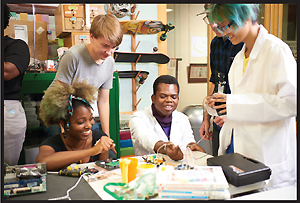 Chicago Public Library (CPL) is no stranger to these pages, figuring as a special mention in 2018 as well. The system goes from strength to strength, innovating on everything from physical plant, with four branches co-locating with affordable housing among 12 new and 18 updated branches, to nationally recognized laundromat story times, and from a partnership with Illinois WorkNet to develop training modules to make the most of this statewide resource to Peer to Peer Learning Circles that successfully change the MOOC narrative and help distance students persist and succeed in online courses thanks to in-person support. These latest twists layer on top of an already impressive portfolio of previous innovations that have become pillars of CPL’s service model: online homework help, which led to a 90 percent increase in program participation; the Maker Lab; YouMedia, the teen-focused space that has since been replicated across the country; the STEAM Team and its outreach vehicle; and staffwide commitment to design thinking methodology. In addition to implementing these locally, to great effect, CPL has been a leader in producing toolkits and trainings to make them replicable across the field at scale. And CPL has proven itself willing to adopt the best practices of others in turn, recently starting a social worker in the library program in partnership with AMITA Health, famously pioneered by San Francisco Public Library. Brian Bannon, Commissioner & CEO of CPL, knows that works firsthand, having been at SFPL before coming to Chicago. Now he’s moving on to yet another major city library, joining New York Public as the first Merryl and James Tisch Director, a position which combines the chief branch library officer role with its educational planning efforts. We are excited to see what further advances will come out of his new role, and of course what’s next for Chicago under new leadership.—Meredith Schwartz
Chicago Public Library (CPL) is no stranger to these pages, figuring as a special mention in 2018 as well. The system goes from strength to strength, innovating on everything from physical plant, with four branches co-locating with affordable housing among 12 new and 18 updated branches, to nationally recognized laundromat story times, and from a partnership with Illinois WorkNet to develop training modules to make the most of this statewide resource to Peer to Peer Learning Circles that successfully change the MOOC narrative and help distance students persist and succeed in online courses thanks to in-person support. These latest twists layer on top of an already impressive portfolio of previous innovations that have become pillars of CPL’s service model: online homework help, which led to a 90 percent increase in program participation; the Maker Lab; YouMedia, the teen-focused space that has since been replicated across the country; the STEAM Team and its outreach vehicle; and staffwide commitment to design thinking methodology. In addition to implementing these locally, to great effect, CPL has been a leader in producing toolkits and trainings to make them replicable across the field at scale. And CPL has proven itself willing to adopt the best practices of others in turn, recently starting a social worker in the library program in partnership with AMITA Health, famously pioneered by San Francisco Public Library. Brian Bannon, Commissioner & CEO of CPL, knows that works firsthand, having been at SFPL before coming to Chicago. Now he’s moving on to yet another major city library, joining New York Public as the first Merryl and James Tisch Director, a position which combines the chief branch library officer role with its educational planning efforts. We are excited to see what further advances will come out of his new role, and of course what’s next for Chicago under new leadership.—Meredith Schwartz
Photo courtesy of Chicago Public Library
LIBRARY OF THE YEAR 2019 JUDGES
LJ thanks the following individuals who volunteered their valuable time to help select the 2019 Library of the Year:
Michael Lambert l Director, San Francisco Public Library; 2018 Gale/LJ Library of the Year
Richard Reyes-Gavilan l Executive Director, DC Public Library, Urban Libraries Council Executive Board member
Brian Risse l VP–Public Library, Wholesale, & Large Print Sales, Gale Cengage Learning
Pam Sandlian Smith l Director, Anythink Libraries; Past President, Public Library Association
Barbara Stripling l Senior Associate Dean and Associate Professor of Practice, Syracuse University School of Information Studies; American Library Association Past President 2013–14
The panel also includes LJ’s Matt Enis, Rebecca T. Miller, Kiera Parrott, Lisa Peet, and Meredith Schwartz.
LJ editor panelists select up to six finalists from among the total pool of entries and invite external judges to participate, including one representative from Gale Cengage Learning, the award’s sponsor; the judges each choose their first-, second-, and third-place candidates from that field and convey their vote to the coordinating LJ editor. Each vote is assigned a corresponding point value, and each vote is given equal weight. The cumulative totals determine each year’s award winner and honorable mentions; any ties are broken by LJ editors.
RELATED
ALREADY A SUBSCRIBER? LOG IN
We are currently offering this content for free. Sign up now to activate your personal profile, where you can save articles for future viewing









Add Comment :-
Comment Policy:
Comment should not be empty !!!